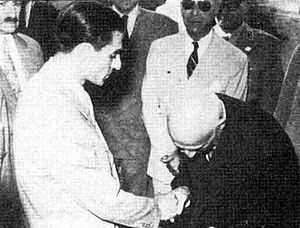Abadan Crisis facts for kids
The Abadan Crisis happened between 1951 and 1954. It started when Iran decided to take control of the Iranian oil business that was run by a British company. This company was called the Anglo-Persian Oil Company (AIOC), which later became BP. Iran made the oil refineries in the city of Abadan belong to the country. They also asked foreign companies to leave.
Why it Started
The AIOC was a very important business for the United Kingdom. It was Britain's biggest business outside its own country. It was also something the British were very proud of after World War II. Some British officials even thought that Iran's oil truly belonged to Britain. They believed this because British people had found the oil, invested money in it, and used their skills to get it.
However, Iran's Prime Minister, Mohammad Mosaddegh, saw things differently. He believed the agreement from 1933, which gave the AIOC rights to Iran's oil, was unfair and wrong. Mosaddegh questioned everything about Britain's oil business in Iran. The British worried that if Mosaddegh succeeded, other countries might also cancel their agreements with Britain without any problems.
Taking Control of the Oil
In March 1951, the Iranian Parliament voted to make the AIOC belong to Iran. This decision was incredibly popular in Iran. People saw it as a way to stop Iran's wealth from leaving the country. They hoped this money could now be used to fight poverty in Iran.
In Britain, however, this was seen as a serious breaking of a deal or even stealing. British officials told the United States that allowing Iran to take control of the oil would be seen as a win for the Soviet Union. They also said it would make Britain lose a lot of money each year. This would harm Britain's military plans and make life more expensive for its people.
British warships then blocked the port of Abadan. On August 22, the British government put in place money-related punishments against Iran. They stopped selling important British goods like sugar and steel to Iran. They also told all British workers to leave Iran's oil fields. Most British managers left Abadan, and Britain stopped Iran from using its money in British banks.
After the British workers left in late 1951, the Iranians thought they could easily hire skilled workers from other countries. They also planned to train their own people quickly. But this did not happen. The United States, Sweden, Belgium, the Netherlands, Pakistan, and West Germany all refused to send their workers to Iran. Only Italy agreed. This showed that most industrial countries supported Britain in the oil dispute.
In July 1952, the Royal Navy (British navy) stopped an Italian oil tanker called Rose Mary. They forced it to go to Aden, an area controlled by Britain. The British claimed the oil on the ship was stolen. News of the British navy stopping tankers scared away other ships. This effectively stopped Iran from selling its oil to other countries.
The Coup d'état
On August 19, 1953, the prime minister, Mohammad Mosaddegh, was removed from power. This happened after a secret plan by the United Kingdom and the United States. During this plan, called Operation Ajax, the American CIA and British MI6 helped bring Mohammad Reza Pahlavi back to power as the Shah (king).
In August 1954, the AIOC was put under the control of a group of international companies. This group was called a consortium. The ownership shares were planned like this:
- 40% for five major American companies (8% each).
- 40% for British Petroleum.
- 14% for Royal Dutch/Shell.
- 6% for CFP, a French company.
Iran now received 25% of the profits from the oil. This was more than the 20% it got from the original agreement with the AIOC. However, at the same time, countries like Saudi Arabia were getting up to 50% of the profits from their oil deals with American companies.
After Iran took control of its oil, the National Iranian Oil Company (NIOC) was created. The AIOC removed its managers from Iran and organized a worldwide ban on Iranian oil. The British government, which owned the AIOC, took the issue to the International Court of Justice. But their complaint was not accepted.
See also
- International crisis
- National Front of Iran
- Abadan Crisis timeline
- Occupation of Bushehr
- Nissho Maru Incident


